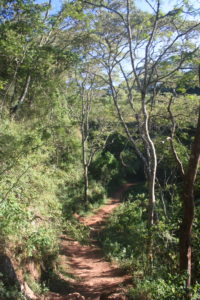The mountain range with peaks up to 14,648 feet (4,507metres), spills over into the neighbouring countries of DRC (Congo – formally Zaire), and Uganda – where mountain gorillas may also be visited. The park contains several vegetation zones from lowland forest to Afro alpine and tall primary rainforest whose low branches are covered in lichen and occasional parasitic orchids.
During the 1990’s, dreadful genocide occurred in Rwanda in a civil war costing more than a million lives. Thousands fled across neighbouring borders and found themselves existing on food aid in squalid refugee camps controlled by an emerging militia. Dispossessed people travelled through the Virunga Mountains and with little to eat they set snares to catch animals like antelopes. Unfortunately the mountain gorillas also fell prey to the traps and to the occasional poacher.
VISITING THE GORILLA’S
The Dian Fossey Gorilla Fund International research station, who have been monitoring and researching the gorillas since Dian Fossey began in 1967, are now re-established after their base was abandoned after it was ransacked. The official park permit system for visiting the three habituated gorilla groups is also running smoothly. Rwanda is arguably experiencing its most stable period in the past 10 years.
Having a close encounter with mountain gorillas is a heart-warming experience that you will never forget, neither is trudging through the damp loamy undergrowth,
Chimpanzee
Often heavy with mist. None of the hardships enter your head once you make eye contact with your first gorilla and the sensation of kinship is almost overwhelming. David Attenborough can attest to this said, “There is more meaning and understanding in exchanging a glance with a gorilla than with any other animal I know.” There are strict protocols in place and each of the habituated gorilla groups receives a maximum of eight people in one visit a day. Meeting these distant cousins of ours is a real privilege.
OTHER ANIMALS
The park contains fourteen species of primates including chimpanzee, red colobus monkey and crested mangabey. Other wildlife include the rarely seen forest elephant – smaller than its savannah counterpart, giant forest hog, little duiker antelopes and buffalo.
SEASONS
The climate is constantly damp with daytime temperatures averaging 50°F (10°C).
Dry Season: June to September and January and February are the driest months and best for gorilla trekking, but be prepared for afternoon thunderstorms at any time.
Rainy Season: long rains are from mid-march to mid-May when many roads become impassible. It also usually rains in October and November.
PARC NATIONAL DES VOLCANS SPECIALITIES
• Spending precious moments with the last of the world’s mountain gorillas
FACTS
The park covers 46 miles² (120 km²) and receives an average of 40 inches (1,020 mm) of rain per year.

